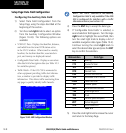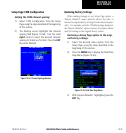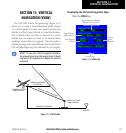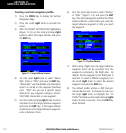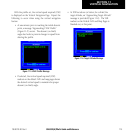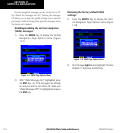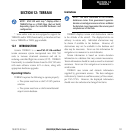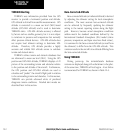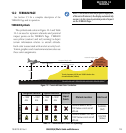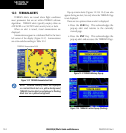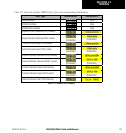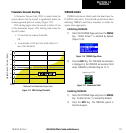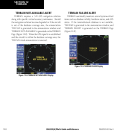
GNS 530(A) Pilot’s Guide and Reference
190-00181-00 Rev. E
12-2
SECTION 12
TERRAIN
TERRAIN Alerting
TERRAIN uses information provided from the GPS
receiver to provide a horizontal position and altitude.
GPS altitude is derived from satellite measurements. GPS
altitude is converted to a mean sea level (MSL)-based
altitude (GPS-MSL altitude) and is used to determine
TERRAIN alerts. GPS-MSL altitude accuracy is affected
by factors such as satellite geometry, but it is not subject
to variations in pressure and temperature that normally
affect pressure altitude devices. GPS-MSL altitude does
not require local altimeter settings to determine MSL
altitude. Therefore, GPS altitude provides a highly
accurate and reliable MSL altitude source to calculate
terrain and obstacle alerts.
TERRAIN utilizes terrain and obstacle databases that
are referenced to mean sea level (MSL). Using the GPS
position and GPS-MSL altitude, TERRAIN displays a 2-D
picture of the surrounding terrain and obstacles relative
to the position and altitude of the aircraft. Furthermore,
the GPS position and GPS-MSL altitude are used to
calculate and “predict” the aircraft’s flight path in relation
to the surrounding terrain and obstacles. In this manner,
TERRAIN can provide advanced alerts of predicted
dangerous terrain conditions. Detailed alert modes are
described later in this section.
Baro-Corrected Altitude
Baro-corrected altitude (or indicated altitude) is derived
by adjusting the altimeter setting for local atmospheric
conditions. The most accurate baro-corrected altitude
can be achieved by frequently updating the altimeter
setting to the nearest reporting station along the flight
path. However, because actual atmosphere conditions
seldom match the standard conditions defined by the
International Standard Atmosphere (ISA) model (where
pressure, temperature, and lapse rates have fixed values),
it is common for the baro-corrected altitude (as read from
the altimeter) to differ from the GPS-MSL altitude. This
variation results in the aircraft’s true altitude differing from
the baro-corrected altitude.
Using TERRAIN
During power-up, the terrain/obstacle database
versions are displayed along with a disclaimer to the pilot.
At the same time, TERRAIN self-test begins. A test failure
is annunciated for TERRAIN as shown in Table 12-4.



